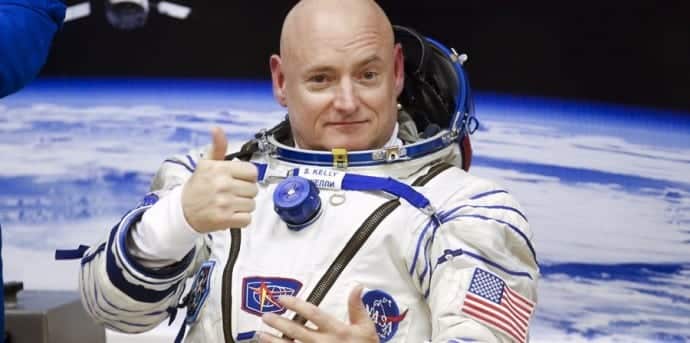Scott Kelly Grew Two Inches Taller After A Year In Space
NASA astronaut Scott Kelly has returned to Earth after living for nearly a year aboard the International Space Station, albeit two inches taller than his twin brother from when he had left.
It is very common among astronauts who spend a significant amount of time in space to gain a couple inches. That’s because the microgravity environment allows room for their vertebrae to expand. Here’s how NASA explains it:
Imagine that the vertebrae in your back form a giant spring. Pushing down on the spring keeps it coiled tightly. When the force is released, the spring stretches out. In the same way, the spine elongates by up to 3% while humans travel in space. There is less gravity pushing down on the vertebrae, so they can stretch out — up to 7.6 centimeters (3 inches).
However, Kelly should return to his regular height after spending some time on the ground. Kelly’s height change was especially striking when he stood to his identical brother, former astronaut Mark Kelly. Each brother has undergone regular testing throughout the year-long experiment, and tests will continue as Scott Kelly readjusts to life on ground.
“Obviously, this is a tiny sample size, so we’re not really looking at how Scott and Mark are different during the year, exactly,” Johns Hopkins Medical School’s Andrew Feinberg told The Washington Post just before Kelly’s launch last year. “It’s not statistically valid to say that differences between them must be due to the spaceflight.”
However, Feinberg added, “if something happens after Scott departs, increases during his trip, and then goes back to normal after he comes back to Earth — if we don’t see that kind of sequential change in his twin, well, it’s not proof of anything, but it certainly suggests something interesting is going on.”
However, being in space comes with a host of negative side effects.
Astronauts and cosmonauts can suffer a loss of vision. Their muscles can decrease, bones shrink, and their heart too may weaken. They may also be damaged by radiation.
When returning to Earth, US astronaut Scott Kelly found it very difficult to adjust when he returned this week. Sometimes, the ability to stand up straight and simply walk around takes a little time to regain, at least in terms of full functionality. However, at least Kelly can stand tall, because he gained a whole two inches during his 12-month mission in space.
“Astronauts get taller in space as the spine elongates,” NASA’s Jeff Williams told CNN upon Kelly’s return, “but they return to preflight height after a short time back on Earth.”
Though he is no longer an astronaut, Mark volunteered to take part in NASA’s “Twins Study” with his brother. NASA wanted to see how the identical twins measure up after a year in two very different environments: Scott in space and Mark on Earth.
The goal of the demanding testing and comparison between the brother’s ongoing physiology is to find out what challenges needs to be addressed before humans undertake long-term space voyages, specifically informing NASA’s plans to venture to Mars within a few decades.
“NASA is working on this science project that’s the greatest in the history of civilization,” Feinberg said last March. “They’re turning humankind from an Earth-dwelling species into a space-exploring species. One day, humankind will be a species that can settle on other planets. It might be a hundred years before we have humans living on Mars, but this is a whole new kind of science. It’s a multi-generational effort.”

